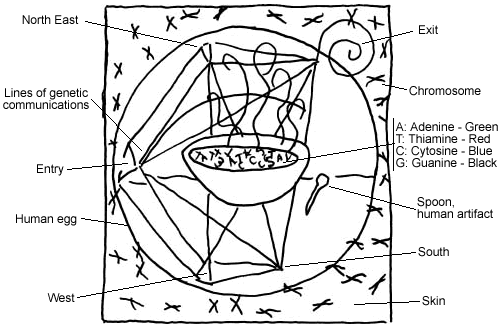|
Chromosomes alphabet soup |
|
|
Warhol was interested in the aesthetics of Campbell's Soup cans. In the creative mind of Jacques Deshaies, soup is metaphorical for the revolutionary changes in human society resulting from the application of DNA technologies. It is the nature of the contents of the soup and not the packaging that is the real story as we enter the 21st century. In
soup, vegetables, meat and spices are blended together to form a new
composition of food. For Jacques Deshaies, soup is a metaphor for the
blending of genes from microorganisms, plants and animals to create
new compositions of hybrid lifeforms. The bowl of soup, a nondescript
vessel, represents the external structure of life forms. The soup bowl
is symbolic of the new relationships being created between species and
genes in the midst of the DNA revolution. The spoon is representative
of the human artifacts, such as recombinant technology and gene sequencers,
which are creating the DNA media that are redefining our very existence.
In nature, species, races and varieties have exhibited migratory patterns. The mutated trellis of life in the background of the painting was loosely created based on diagrams illustrating human migratory patterns. These species-based, evolutionary patterns of genes both mutating and migrating over time is forever revolutionized when biotechnology enables human scientists to extract and insert genes from any and all species at will. The iconoclastic nature of revolutionary DNA technologies will eventually filter down to the everyday life of the common man. To reflect the anticipated future pervasiveness of these technologies into everyday life, Jacques Deshaies the painter employed a North-American folk art technique to reveal the relative naivety of the common man in comparison to the expert knowledge of the genomic scientist. Contemporary folk art is very naive and documents life experiences. The chromosome soup painting "seems" to be naive. But in its conception, imagination and realisation it is very complex. Thus the "soup painting" is like an "average man", untrained in painting techniques and art history, documenting the DNA culture as it affects the "everyday life" of the "average man". The subject
matter, it's symbolism, it's inspiration and Jacques Deshaies's treatment
of space and time are of course very modern. This knowledge-based work
of art is a symbolic representation of intellectual realism. Thus, in
this painting there is an element of primitivism/modernism like Jacques
Deshaies's earlier "Love of Spirit of DNA" series. In this
series, the modern spirituality of DNA was captured in a style representative
of bronze age cave paintings. Contemporary folk art and DNA technologies
reflect the emerging social dichotomy - primitivism / modernism - of
a North American society about to enter the 21st century. Jacques Deshaies
paints that story. by
Jock Langford, Environnement Canada - Ottawa - Nov. 1997 |
|

